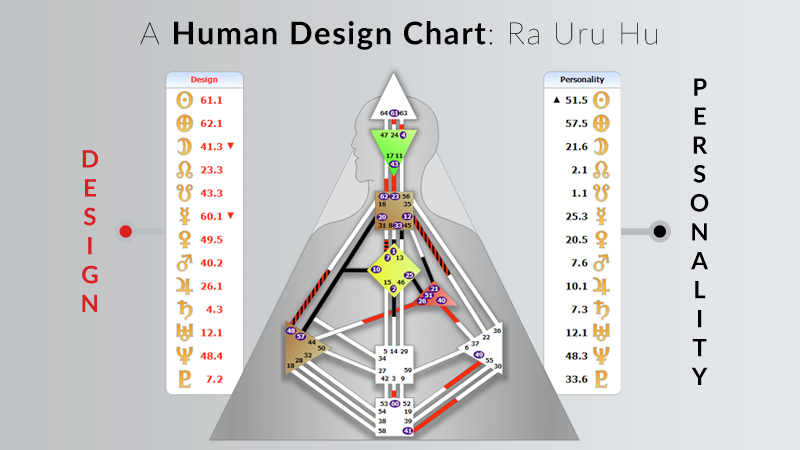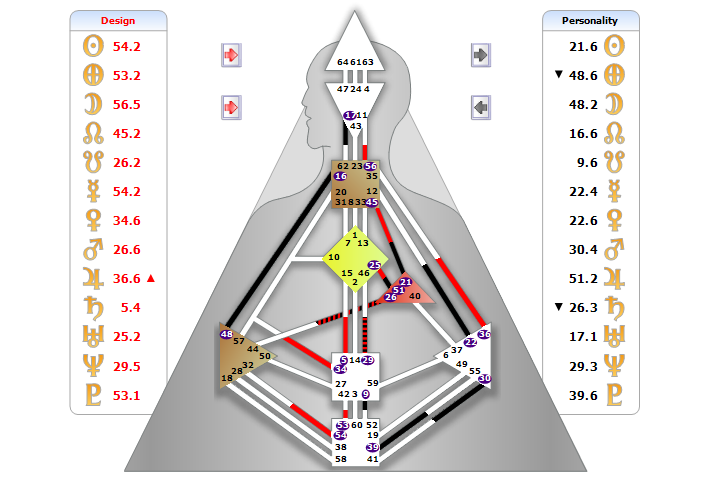Personality and Design, Gates, and Channels
If you’re new to Human Design, upon finding out your Rave bodygraph you will see a colorful array of red and black numbers, lines, and symbols. You may think to yourself, what exactly am I looking at? This blog post is here to discuss what exactly makes up one’s chart.
Let’s get started.
The Conscious and Unconscious

In the image above, you can see there are two columns on either side of the body graph. These columns summarize the different numbers, called gates, that are defined in one’s chart, letting viewers know which planets the gates fall into and what lines they’re in. The gates can fall under the Personality, Design, or even both.
THE CONSCIOUS PERSONALITY
Gates that are in the Conscious Personality are black. These numbers are considered to be the conscious mind. You will most-likely feel a sense of understanding when looking at your conscious chart because these gates are the ones that were present at your birth. You might think to yourself, ‘Ah, that makes sense!’
THE UNCONSCIOUS DESIGN
The Design, on the other hand, is based on when your soul entered the body, which, according to Human Design, was 88 days before your birth time and day. Gates falling into the Design part of your chart are red in appearance. Because the Design is unconscious, it is often less-easily identifiable with who you know yourself to be. The gates in your Design are considered to be the unconscious body, and they play a physical role in your life.
The Gates and Channels
Gates
There are 64 gates in Human Design that occupy the 9 different centers. The gates originated from what is called the I Ching (or Yi Jing). In the I Ching, there are 64 Hexagrams, meaning each of the numbers has 6 points that form the shape of a hexagram.
Similarly, Human Design has 64 gates that have 6 lines. These 64 gates are fixed in their locations within any given chart, but only some of the gates are defined or active within one’s chart. When they are defined in one’s chart, they can take the form of any of the 6 lines of the Hexagram, which alters the expression of that gate. Gates that are defined in one’s personality appear in the appropriate centers within one’s Bodygraph in the form of dark purple circles with white numbers.
Depending on whether or not a gate is Conscious, Unconscious, or both, a red, black, or striped line will branch off from the number. If two numbers meet each other as they branch off, they create what is known as a channel.
Channels
Channels change the way the gates involved operate. While defined gates consistently operate in a certain way, depending on the gate and line, a channel is a whole new relationship between two gates in two different centers.
In the image below, you can see all of the gates circled in dark purple, and the corresponding lines branching outwards. Gates whose lines intersect with one another form channels, which is evident by the center being colored in.
Centers that are white with only black numbers are considered open, while centers that have any numbers circled in purple are considered undefined.

Let’s look more closely at a few of Angelou’s gates and channels.
Angelou has gate 5 circled in purple. It has a red, unconscious branch coming out of it, but because gate 15 is not defined, this gate is hanging by itself. If we look at her Design on the left, we can see the specifics of this gate. Towards the bottom of her Design gates, we see gate 5 in line 4 in the planet Saturn. Let’s break down what this gate means, so that you can look at your own chart and see how to interpret its many-dimensions:
- Gate 5- This is the gate of Fixed Patterns. Those with this gate defined need patterns and stable rituals to feel most comfortable.
- Line 4- Because Angelou’s gate 5 is in line 4, the expression of the fixed patterns will vary. Line 4 is the line of the Opportunist, so Angelou experiences her gate 5 through the lenses of rhythmic opportunities. She may be more likely to transform her fixed rhythms into something beneficial, rather than passive.
- Planet Saturn- This is where Human Design incorporates elements of Astrology to its system. Saturn, is where we struggle to achieve growth. Because her 5th gate is in Saturn, that gate experiences yet another layer to it. Angelou might find she struggles to achieve her goals of transforming her rhythms into something that works for her.
Angelou also has a few channels in her chart. To keep it brief, I’ll refrain from diving into how the planets these gates are in impact the channel’s expression. So, without further ado, let’s finish up by having a look at the Channel of Talent, 48-16:
- Gate 16.6- Gate 16 is the gate of skills, and in line 6, it’s all about trial and error, reflecting upon the lessons learnt, and then sharing the experience with others. These 3 stages of the 6th line, known as the Role Model, happen in approximately 27-year intervals. Thus, Angelou has the ability to experiment with her skills, learn from it, and then express it.
- Gate 48.6 and 48.2- Gate 48, the gate of depth, appears twice in Angelou’s body graph. This means it has two different forms of expression. In the 2nd line, gate 48 operates in a way that is focused on finding a healthy balance between good technique and unhealthy form. In the 6th line, its expression is that of perfecting the form. For example, a skilled musician is skilled because s/he designated hours and years to perfecting their technique, uncovering the challenges and working to achieve mastery.
- As a channel- Together, both gate 48 and gate 16 interact and form the Channel of Talent. This channel is all about perfecting the form and expressing that form with the collective.
As you can see, Human Design is truly unique to the individual. Someone whose chart looks similar to another’s could have gates, channels, lines, and planets that alter the ways in which those gates are expressed.
Many people end up having a Human Design specialist do a chart reading for them because of the extensive information one has to learn in order to understand the system. While chart readings can be useful, it is possible to experiment with your design without a chart reading. That’s one of the reasons why I’ve created this blog.
In the future, I plan on writing a FAQ section that covers confusing areas of Human Design. Please subscribe and feel free to ask me questions below for more information on the particulars of your chart

Comments
Post a Comment
Please feel free to leave a reply.